Port of Cherbourg, France
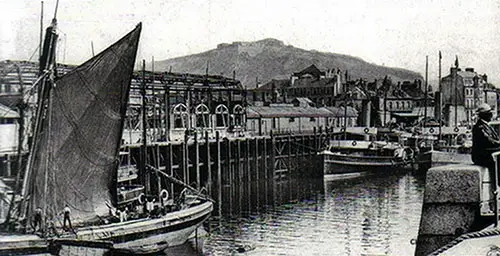
Busy Harbor Scene at Cherbourg Showing Tenders in the Foreground and the Passenger Train Station in the Background. | GGA Image ID # 1457da585e
Cherbourg has attained a position of importance as a port of call for transatlantic liners because of its 40-mile proximity to the routes followed by vessels plying between North and South American ports and Southampton.
Development of Cherbourg as a Transatlantic Port (1932)
Cherbourg has attained a position of importance as a port of call for transatlantic liners because of its 40-mile proximity to the routes followed by vessels plying between North and South American ports and Southampton or between North and South American ports and North European ports via Plymouth or Cobh.
The admirably sheltered roadstead permits the transfer of passengers and baggage from liners to tenders and vice versa in any weather and at any tide. In 1931, 746 transatlantic liners, representing 10,725,000 net tons, 115,000 passengers, and 513,000 sacks of mail, entered and cleared the port.
Present High Rank in Use and Plans for Extending Facilities.
Cherbourg ranks first among European ports in the number of trans-Atlantic passengers embarked and disembarked; it ranks second only to Marseille among French ports in the tonnage of vessels entered and cleared; and it ranks twentieth in cargo traffic, with only 294,000 tons during 1931.
Competition between ports for trans-Atlantic traffic, inadequate present facilities, and the advantages of having vessels docked were the main factors at Cherbourg that led to plans for the port's development.
The ambitious plans for the development of Cherbourg's port include the construction of an unparalleled transatlantic passenger station, the establishment of deep-water quays specifically for liners, and the attraction of a steamship line or lines to make Cherbourg their European home port. They also wanted to reduce the travel time from Cherbourg to Paris and advocate for the relaxation of current governmental restrictions on landing commercial and private airplanes at Cherbourg.
Harbor Improvements
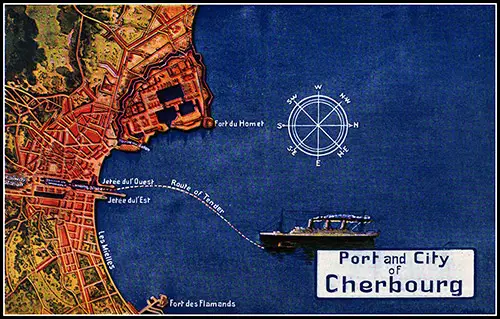
Map of the Port and City of Cherbourg Showing Route of Tender used by the Steamship Lines. Hamburg-American Line, Summer 1913 Edition, p. 191. | GGA Image ID # 1d1e773433
The harbor of Cherbourg comprises an area of 15,000,000 square meters (3,707 acres), lying between the point of Querqueville and the Isle Pelee, which are approximately 7 kilometers (4 1/3 miles) distant from each other. The harbor is protected on the west by the Querqueville breakwater, in the center by a breakwater 4 kilometers in length, and on the east by the Tourlaville breakwater.
The channel between the east and center breakwaters is 1,000 meters (3,280 feet) wide and has a depth of 12 meters (39 feet) at extreme low tide; the channel between the east and center breakwaters is 700 meters (2,297 feet) wide and has a depth of 8 meters (26 feet) at extreme low tide.
The harbor is divided into an inner and an outer, or principal, roadstead by the Homet and Flamands breakwaters, which are separated by a channel 500 meters (1,640 feet) wide connecting the two roadsteads. The Flammands breakwater, constructed between 1924 and 1927, will protect the piers of the new trans-Atlantic passenger station.
The depth of the greater part of the outer roadstead varies from 13 to 14 meters (43 to 46 feet) at extreme low tide. The new station and piers are being constructed in the inner roadstead.
When dredging operations in the inner roadstead have been completed, a zone 800 meters (2,625 feet) in diameter will be available to maneuver trans-Atlantic steamships. By January 1933, the maneuvering zone is expected to be dredged to a depth of 9 meters (29 feet) at extreme low tide.
The berthing space for trans-Atlantic steamships, which is now under construction, will be 620 meters (2,034 feet) long and 242 meters (794 feet) wide.
Transatlantic steamships will use the quays on its east and west sides; the 242-meter quay on the southern side will be used for tenders, tugs, excursion boats, or steamships of which the length is less than 240 meters (787 feet).
The northern half of this berthing space will be dredged to a depth of 13 meters (43 feet) below extreme low water and the southern part to a depth of 12 meters (39 feet), with the exception of the immediate vicinity of the south quay, where the depth will be from 10.50 to 11 meters (36 feet).
The wall of Quay No. 1 (west quay) has been completed, and the construction of Pier No. 2 started. Three to four years will be required to complete Pier No. 2 and to dredge the maneuvering zone and the berthing space.
The dredged material is being used to foundation a new sand beach, build piers, and reclaim land from the sea. This reclaimed land, which will form an area of 70 hectares (173 acres), will be used for storage warehouses, etc.
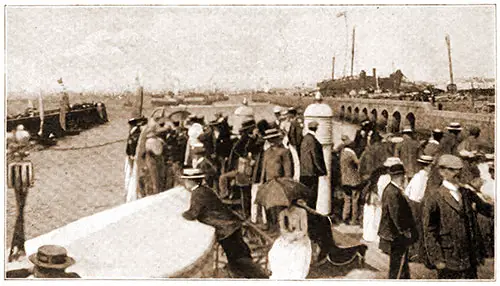
English Visitors on the "Cambria," After Passing the French Fleet, Entering the Port of Commerce, Cherbourg. Photo by Stephen Cribb, Soutsea. The Sketch Magazine, 1 August 1900. | GGA Image ID # 162527c50f
Improvements Planned for the Future.
The future plans for the port, which are not included in the present construction program, include two additional berthing spaces 600 meters (1,968 feet) long by 170 meters (558 feet) wide, two additional piers, an extension of the maneuvering zone, and the creation of reclaimed land for possible use as an airplane landing field in connection with the arrival and departure of trans-Atlantic steamships.
New Transatlantic Passenger Station. The construction of the new transatlantic passenger station is nearing completion. The principal building is 280 meters (919 feet) long and 42 meters (138 feet) wide.
Above it are towers holding water reservoirs and a campanile that rises 67 meters (220 feet) above the pier. On the second floor of this building are the waiting rooms, rooms for customs formalities, and offices of the steamship companies.
The rooms are so arranged that two steamships may dock at the same time without confusion. The ground floor of this building is occupied by a network of five railway tracks, be used as a yard for rolling stock or for the spec boat trains.
Nine metal gangways will allow passengers to access the steamships. Each gangway is divided into three sections: one for embarking passengers, one for those disembarking, and a mechanically driven endless belt for carrying hand luggage.
The equipment of the station will include seven electrically powered cranes, all moving on rails. Orders have been placed for 40 electrically propelled baggage vans and 10 tenders or vans without motors. Six elevators are to be installed.
DISEMBARKATION OF PASSENGERS AT CHERBOURG
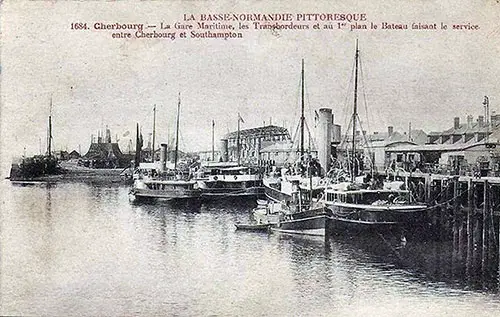
At Cherbourg, the Maritime Station, the Tenders, and in the Foreground, a Full-Service Boat that Shuttles Between Cherbourg and Southampton. | GGA Image ID # 145811ac30
In the event of the steamer not being able to land passengers sufficiently early to allow of their reaching Paris before the early hours of the following morning, there is at Cherbourg a comfortable hotel, the Casino, which can accommodate anyone who wishes to stay overnight in Cherbourg, and travel to Paris during the daytime. The Purser can arrange reservations by wireless.
The stewards carry hand baggage from the steamer to the tender. Passengers are informed that they are solely responsible for their hand baggage from the time it is on the tender. They must see that it is passed through Customs and placed on the special train in their carriage.
All hand baggage not claimed on the tender or left in the Customs is collected and included with registered baggage for Paris. A charge of Fr 20.00 per package applies to these packages, Cherbourg—Paris.
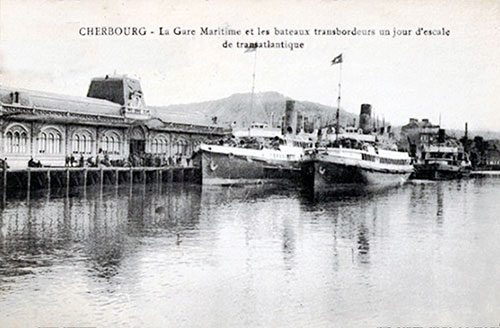
View of the Passenger Train Station at Cherbourg and Tenders on a Day of Transatlantic Sailing. | GGA Image ID # 145838c957
Passengers are advised that the Cunard Company cannot be held responsible for any loss or damage caused by passengers not claiming their hand baggage on the tender.
All baggage registered in New York for Cherbourg only, if not claimed at the port, is forwarded directly to Paris. A charge of Fr. 20.00 per package is made irrespective of size or weight. (Heavy nailed cases or bulky packages will be charged as freight.)
Conditions at Cherbourg (1922)
In the struggle to take a prominent place among the Atlantic ports of the Continent, one of the most favorable competitors seems to be Cherbourg. British, American, French, and German shipping companies used this famous French port in the course of their ocean trade. The port authorities are keen on bringing Cherbourg to the fore In European shipping circles. But the port has a long way to go yet before It can fairly be placed among the leading harbors of Europe.
The depth of water in the main port is 40 ft., which allows all types of modem shipping to use the port. These include vessels of the Cunard. White Star, Royal Mail, Red Star. United States Line, American Line, Lloyd Royal Beige, and the Lloyd Royal Hollandais, as well as French lines. In a recent report on the harbor, which covers an area of 3,725 acres, Monsieur Jean Hersent stated:
"Situated exactly on the route of the liners destined for the North Sea, the port of Cherbourg has become by force of circumstances our greatest port of call for foreign lines to America, which have almost all adopted It as a ’speed port' for the transit of travelers." And that "Cherbourg was the object of the solicitations of seven great foreign companies whose liners—veritable giants of the sea—could carry out there in all circumstances the trans-shipment of their passengers and the discharge of their cargo."
The choice of the companies was, in fact, dictated by the permanent conditions of the port of Cherbourg—its geographical situation on the steamer route, the security of landing, even in stormy weather, and the ease of operations on the roads at any time.
The companies themselves are engaged in creating on land some permanent establishments for the lodging of emigrants. The White Star and the Canard particularly have built a splendid hotel provided with the most modern improvements, of which Commodore Todd of the United States Health Department has sailed; "Nothing In the world was to be compared with It."
Movement of Passengers at Cherbourg - 1913
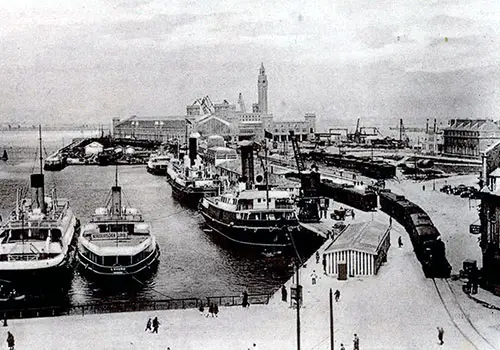
Steamships Docked at the Landing Stage at Cherbourg-Octeville. Train Station is in the Far Background. | GGA Image ID # 1458814588
Cherbourg is one of the chief ports of call in Europe for steamers engaged in the trans-Atlantic service. The vessels of the American, White Star, Hamburg-American, and North German Lloyd Lines call here either on the outward or return voyage, or both, and the movement of passengers between Cherbourg and Paris is very large.
Of the trans-Atlantic passengers embarking and disembarking at Cherbourg in 1912, those en route to New York numbered 22,713 and those arriving therefrom 24,051. No steamer of a trans-Atlantic line calling at Cherbourg is allowed to load or to land there anything but passengers' baggage.
Therefore, there is no freight movement in connection with this trans-Atlantic service. Commodious and well-equipped tenders meet incoming steamers at a point under the shelter of the outer breakwater of the harbor, where conditions are favorable to the transfer of passengers at all tides and even in stormy weather. The tenders land the passengers at the new maritime station, where the express trains of the State Railway are in readiness to take them to Paris.
Passengers at Cherbourg - 1907
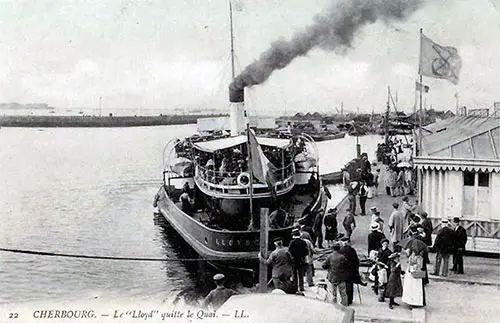
The Norddeutscher Lloyd Tender Departs with Passengers at Cherbourg Quay. | GGA Image ID # 145897a4fd
The steamers anchor in the Rade de Cherbourg and passengers are transferred from the ship to the shore by a fine large tender owned and operated by the company specifically for this purpose, with the tenders of other companies as auxiliaries when necessary. The run to Paris by special trains takes about six and a half hours.
Cherbourg is located at the northern extremity of the peninsular of the Contentin, about seventy miles from the English coast. The town's site is historically interesting, largely because its isolated position and proximity to England exposed it to frequent attack and made it a natural base for invasion.
Cherbourg has become the most important gateway for Americans planning a trip to the Continent, and the principal transatlantic lines include this port now in their itineraries. The great continental metropolis, Paris, is only a few hours distant by fast trains, and lines radiate from it to all parts of Europe.
It is the most convenient center for trips into Germany, Switzerland, Spain, the French and Italian Rivieras, and travelers en route to Egypt and the East find the most expeditious routes conveniently accessible by magnificent trains deluxe via Marseilles and Brindisi.
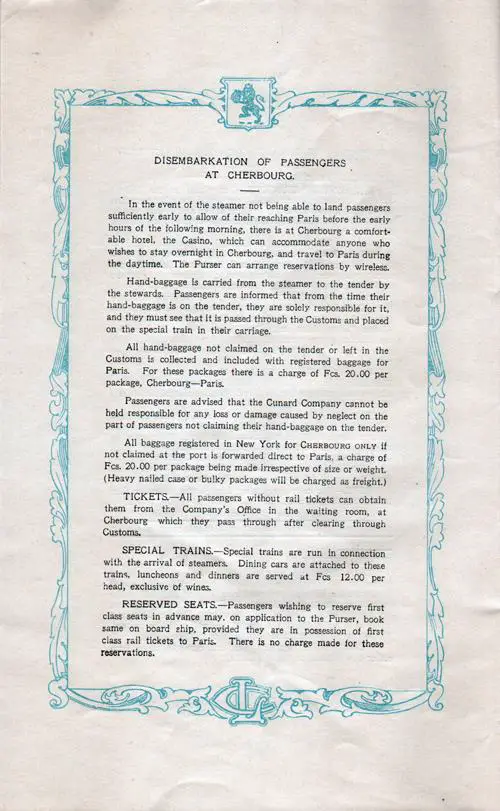
Passenger Information: Cherbourg Disembarkation, 1928. RMS Laconia Passenger List, 24 August 1928. | GGA Image ID # 1e9b0b525a
In the event of the steamer not being able to land passengers sufficiently early to allow of their reaching Paris before the early hours of the following morning, there is at Cherbourg a comfortable hotel, the Casino, which can accommodate anyone who wishes to stay overnight in Cherbourg and travel to Paris during the daytime. The Purser can arrange reservations by wireless.
The stewards carry hand baggage from the steamer to the tender. Passengers are informed that they are solely responsible for their hand baggage when it is on the tender. They must see that it is passed through Customs and placed on the special train in their carriage.
All hand baggage not claimed on the tender or left in the Customs is collected and included with registered baggage for Paris. For these packages, there is a charge of Fr. 20.00 per package, Cherbourg—Paris.
Passengers are advised that the Cunard Company cannot be held responsible for any loss or damage caused by neglect by passengers not claiming their hand baggage on the tender.
All baggage registered in New York for Cherbourg only, if not claimed at the port, is forwarded directly to Paris., with a charge of Fr. 20.00 per package being made, irrespective of size or weight. (Heavy nailed cases or bulky packages will be charged as freight.)
TICKETS.—All passengers without rail tickets can obtain them from the Company's Office in the waiting room at Cherbourg, which they pass through after clearing through Customs.
SPECIAL TRAINS.—Special trains are run in connection with the arrival of steamers. Dining cars are attached to these trains, and luncheons and dinners are served at Fes 12.00 per head, exclusive of wines.
RESERVED SEATS.—Passengers wishing to reserve first class seats in advance may, on application to the Purser, book same on board ship, provided they have first-class rail tickets to Paris. There is no charge made for these reservations.
Sailing Schedules that Include the Port of Cherbourg
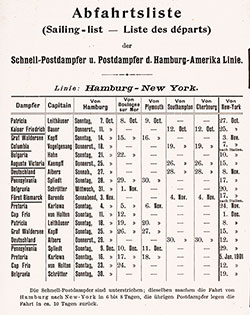
Hamburg American Line (HAPAG) Sailing Schedule, 7 October 1900 to 19 January 1901
Steamers and Ocean Liners operated by the Hamburg Amerika Linie / Hamburg American Line (HAPAG) were scheduled for transatlantic voyages between 7 October 1900 and 19 January 1901.
Bibliography
Vice Consul Tyler Thompson (Cherbourg, France), “Development of Cherbourg as a Trans-Atlantic Port,” in Commerce Reports, Vol. 3, Nos. 27-39, Washington, DC: US Government Printing Office, July-August-September 1932, p. 105-106
"Disembarkation of Passengers at Cherbourg," from the Cabin Class Passenger List of the RMS Laconia, Cunard Steamship Line, 24 August 1928, p. 25.
"Conditions at Cherbourg," in Shipping: Marine Transportation, Construction, Equipment and Supplies, New York: Shipping Publishing Co, Volume 15, No. 5, March 10, 1922 P. 39.
Department of Commerce, "Movement of Passengers at Cherbourg," in Daily Consular and Trade Reports, Volume 2, Nos. 75-151, April-June 1913, Washington: US Government Printing Office, 1913, p.
Percy V. G. Mitchell "The New Service of the White Star Line to Plymouth, Cherbourg, and Southampton," (Excerpt: Passengers at Cherbourg), in Facts of Interest to Travelers and Importers, By Rail or Water, Edition 1907, Baltimore, Arthur W. Robson, p.46
